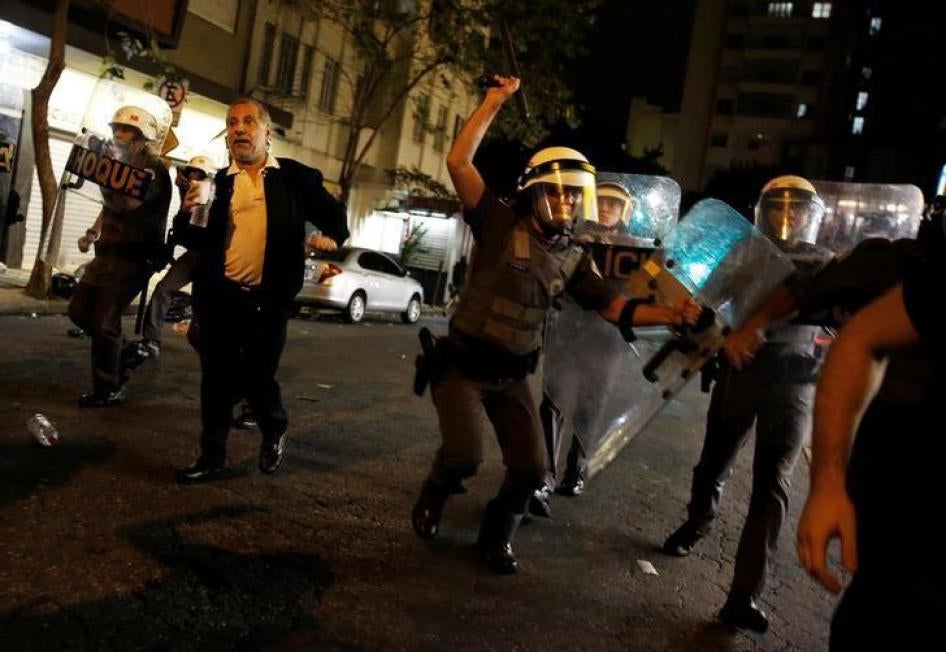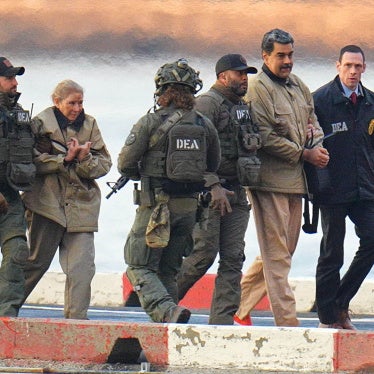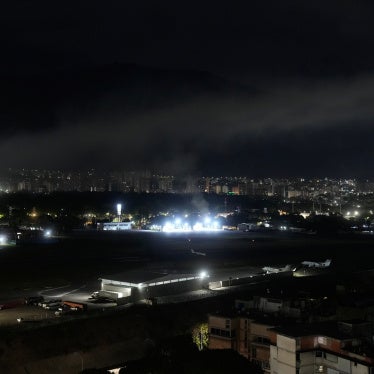(São Paulo) – Brazilian authorities should conduct thorough and impartial investigations into the police use of force and detentions of protesters during recent anti-government demonstrations, Human Rights Watch said today.
The demonstrators were protesting the impeachment of Dilma Rousseff, who lost the presidency of Brazil on August 31, 2016, and was replaced by her former vice president, Michel Temer. The largest demonstration took place in São Paulo on September 4, which organizers said attracted 100,000 participants.
Several videos publicized by news media and posted on social media point to the apparent excessive use force by police, including officers who appeared to purposely hit a protester with a patrol car, beat a lawyer and a reporter, and shoot rubber bullets and to use pepper spray on protesters at short range.
“Brazilian authorities need to ensure that the police respect the rights of protesters and journalists,” said Maria Laura Canineu, Brazil director at Human Rights Watch. “That means providing clear instructions on proper forms of crowd-control, and ensuring that any officers who use excessive force or commit other abuses are held accountable.”
New protests are scheduled for September 7.
One of the videos shows a patrol car chasing a protester in São Paulo on September 1. The driver of the car appears to intentionally hit the protester, who runs alone. Afterward, the officers handcuff the man and put him in the back of the vehicle. A video recorded the same day in Caxias do Sul shows police hitting a lawyer repeatedly with their batons. The man later said he had approached the officers while they were detaining two protesters and identified himself as an attorney.
Another video from September 4 shows a São Paulo police officer using pepper spray at short range against seemingly peaceful protesters as his patrol car passes them. A BBC reporter said several police officers hit him with their batons even after he identified himself as a journalist. A video of a protest the same day in Belém appears to show a police officer shooting a protester in the head at close range with a rubber bullet.
During a protest on August 31 in São Paulo, a stun grenade exploded near a 19-year-old student, whose eye was apparently perforated by a fragment, seriously injuring her.
Police detained 18 adults and eight children before the September 4 demonstration started in São Paulo, alleging they were going to participate in acts of vandalism. Officers said they found stones, masks, and an iron bar with some of the people they had detained, while the detainees claim the police planted the iron bar. Attorneys and family members said the police denied them contact with the detainees for five hours, and interrogated them without a lawyer. A judge released those who were over 18 on September 5, after ruling their detention was unlawful. Another judge released the eight children the same day.
On August 31, police detained two photographers who were covering the protests in São Paulo. One said police officers beat him and destroyed his equipment, news media reported. They were released the next day
While the demonstrations have been largely peaceful, some protesters have engaged in acts of violence and vandalism, including throwing bottles at police officers, destroying bank windows, and setting garbage on fire in the streets, the police and news media reported.
International human rights treaties ratified by Brazil and the country´s own constitution obligate the government to safeguard the rights of freedom of expression and association. Authorities should ensure that any acts of violence by protesters are met with a proportionate response, Human Rights Watch said, while also respecting the right of protesters to demonstrate.
The UN Basic Principles on the Use of Force and Firearms by Law Enforcement Officers state that law enforcement officials “shall, as far as possible, apply non-violent means before resorting to the use of force and firearms.” Whenever the use of force is unavoidable, security forces should “[e]xercise restraint in such use and act in proportion to the seriousness of the offence and the legitimate objective to be achieved,” the principles say.
“If any protesters engage in violence, the authorities have every right to bring them to justice and restore order,” Canineu said. “But that does not justify the use of excessive force against demonstrators.”









